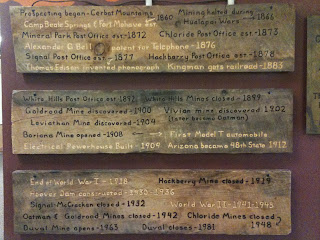Before the railroads made it west, supplies had to come by ocean steamers from San Francisco, down and around the tip of Baja California - over 1,900 miles! - then up the Gulf of California to the mouth of the Colorado River near Yuma, Arizona. It was then off-loaded onto paddle-wheelers and carried another 300 miles north to Parker and Hardyville. From those docks, supplies were put into wagons and onto backpack mules to carry across the desert to the many different mining camps.
Where there was room enough for two horses or mules to pull side by side, wagons would take over. But wagons were hard to control going down a mountain and could be too much of a load for a team to pull up a mountain.
 The wagons were so heavily loaded that they wore these tracks into solid rock over a period of 30 or so years. The divots you see in the side of the rock here on the White Cliffs Wagon Road are where teamsters would place poles used to help push the wagons along much like longshoremen did on rivers, or to help hold a wagon back if they were headed downhill. There's speculation that one man cleared this particular area to create a "road" and then charged a toll for folks to use it. Each day he would have to travel the road to clear the rocks and debris from the path.
The wagons were so heavily loaded that they wore these tracks into solid rock over a period of 30 or so years. The divots you see in the side of the rock here on the White Cliffs Wagon Road are where teamsters would place poles used to help push the wagons along much like longshoremen did on rivers, or to help hold a wagon back if they were headed downhill. There's speculation that one man cleared this particular area to create a "road" and then charged a toll for folks to use it. Each day he would have to travel the road to clear the rocks and debris from the path.All of that effort against the trials and tribulations of nature - AND they were subject to Indian attacks, too. An all-out war between the Hualapai and miners raged from 1866 to 1871.
Millions of dollars in precious gold, silver and other minerals such as turquoise, molybdenum, galena (a by-product of lead and silver now used as the semiconductor for wireless sets) and silver chloride (used in the relatively new art of photography) were taken from the Mohave County earth. One year, from July, 1889 to July of 1890, nearly $1 million ($25 million in today's currency) of ore was hand chiseled from these mountains of rock. That's what made it worth the price (physical and fiscal) to haul things by sea and by land to the Kingman area and the ore back out.
There was always some refreshments waiting for the miners in Kingman, though. This "billboard" for a Kingman saloon is still visible on the side of the toll road! (Sure wish today's paint would last as long as this guy's did!!)
But eventually the railroads did make it to the area. The A & P (Atlantic and Pacific) in 1883, and by 1899 a single spur made it's way from Kingman to Chloride, Arizona. That spur became known as the CB&F: Chloride Back & Forth. By 1900, there were over 2,000 miners working 700 claims around this area, and the city of Chloride was coming of age. They put an ordinance in place: No person shall appear in a public place naked or in a dress not belonging to his or her sex. Yes, time does tend to tame us all, eh?
 From 1900 to 1919 the Goldroad Mine in the Oatman area, discovered when a man went looking for his lost burro, gave up over $7 million dollars worth of gold (about $175 million in today's dollar). The government closed this mine and many others like it in 1942 because they weren't considered vital to the World War II "effort." It seems that Molybdenum was in much greater demand to carry out the industrial functions of World War II. Nowadays, it is far more valuable than even copper!! "Moly" is alloyed with iron to make things like hard, high speed cutting tools.
From 1900 to 1919 the Goldroad Mine in the Oatman area, discovered when a man went looking for his lost burro, gave up over $7 million dollars worth of gold (about $175 million in today's dollar). The government closed this mine and many others like it in 1942 because they weren't considered vital to the World War II "effort." It seems that Molybdenum was in much greater demand to carry out the industrial functions of World War II. Nowadays, it is far more valuable than even copper!! "Moly" is alloyed with iron to make things like hard, high speed cutting tools.You might also be interested in mining in the Grand Canyon:
http://thetravelerstwo.blogspot.com/2013/09/mining-at-grand-canyon.html
and in the southeastern part of Arizona:
http://thetravelerstwo.blogspot.com/2013/11/mining-around-tombstone.html
If you like our blog,
you can "subscribe" for free by clicking on the broadcast icon at the
top right corner or by bringing out the right hand toolbar and clicking on that
icon at the bottom of the list. It will
put that icon on your toolbar at the top of your browser screen. I try to post every day - it'd be a shame for
you to miss one! On your iPhone, you can
create an app by "adding to home screen," bookmark it, or add it to
your Reading List, share it on Twitter or Facebook. Any way you do it, it's free!


















































